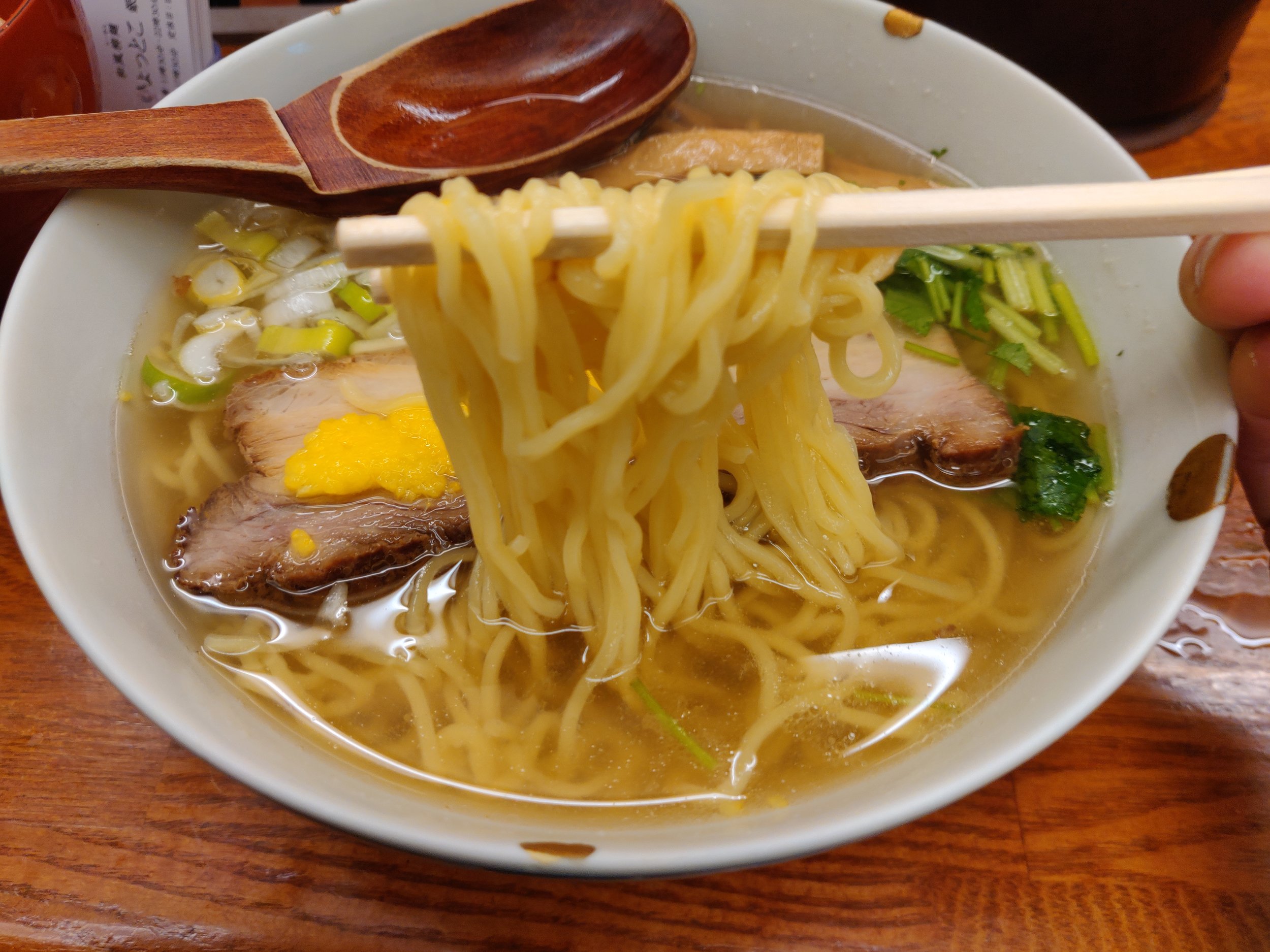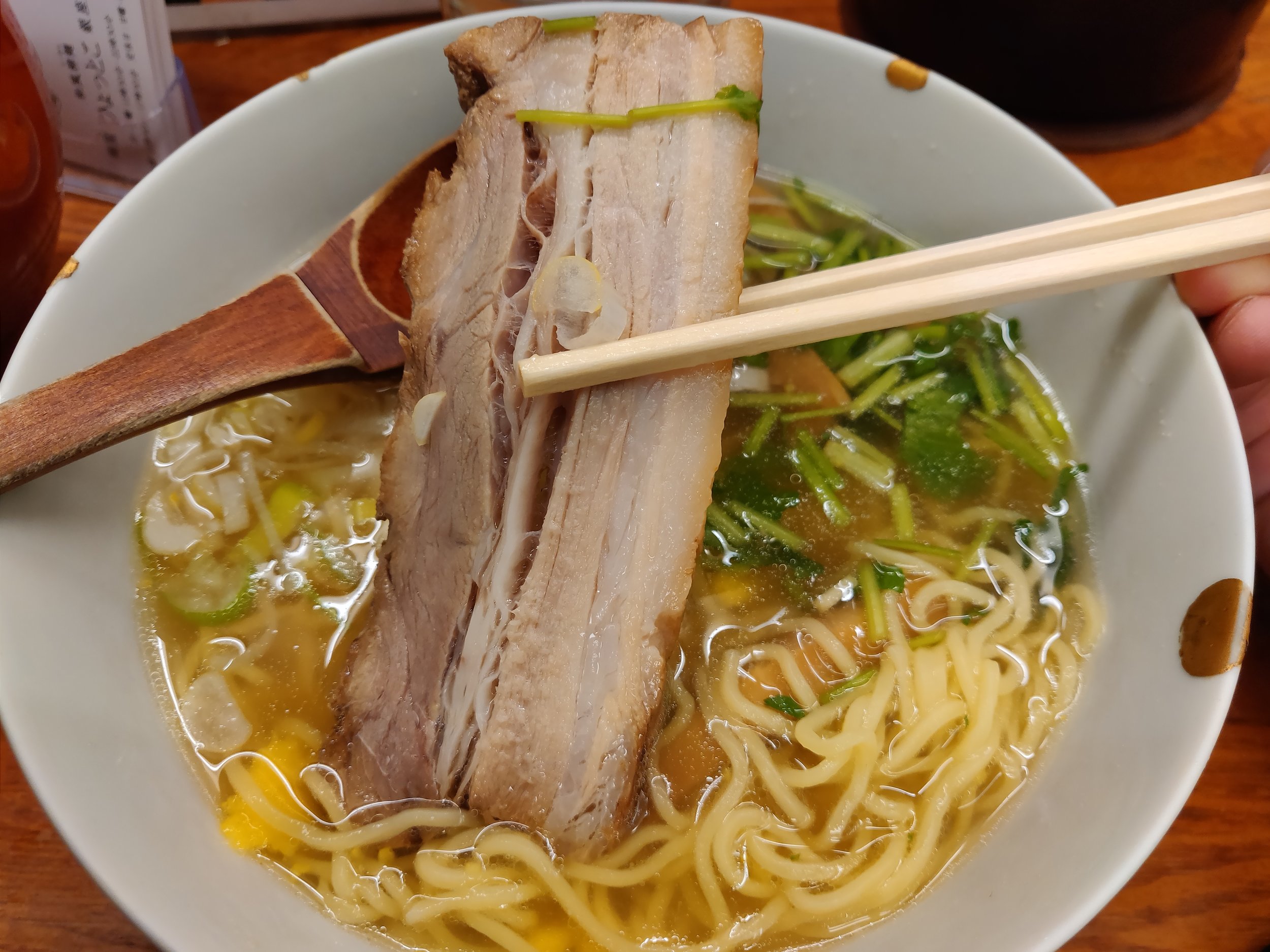Menya Hyottoko (麺屋 ひょっとこ), The Original Yuzu Ramen Shop, Yurakucho
Back in the early 2000s, a particular citrus fruit became popular within ramen circles for its sweet, zesty, and sour flavor notes which pairs fairly well with a number of ramen broths. While Afuri gained a huge following for their rendition of the Yuzu Ramen, one of the originators that doesn’t get the same following is Menya Hyottoko. Although Hyottoko is more highly rated by ramen magazines and publications, a number of reasons keep it from being as popular as Afuri. Firstly, its in a office heavy district of Yurakucho with few customers outside of workers in the area. Second, their small shop limits the number of bowls they can serve in a day, which has hampered their expansion plans. Hyottoko was finally able to expand to Ginza earlier last year and has thrived, which has comes as no surprise to anyone familiar with their bowl. The recipe here is loved by all the salarymen who work nearby and is slowly reaching the masses.
The shop is located in the basement floor of Tokyo Kotsu Kaikan, which is connected to the JR Yurakucho station. Tokyo Kotsu Kaikan is actually the building to come to in central Tokyo when you need to get your passport renewed. My first time dining at Hyottoko was back in 2006 when I went to get my passport before heading off to university in the States and I had no idea of its reputation at the time. I had a few hours to kill until my appointment and decided to have lunch here as I arrived early. Honestly, I wish I could tell you I’ve been a regular for years, but I finally made it back after a 13 year hiatus to write this review. Anyways, the shop is open Monday-Friday from 11:00-20:00 and on Saturdays from 11:00-19:00. Hyottoko is closed on Sundays so be sure to check the day of the week when planning your visit here. The menu is quite simple with just two ramen varieties, the regular ramen and the Yuzu ramen. The prices differ based on the toppings you decided to get with your ramen. Items on the ticket machine are numbered so I will describe them by number. 1 is the Wafu Ramen (regular ramen), 2 is the Wafu Yuzu Ramen (yuzu ramen), 3 is the Wafu Char Siu Men (regular ramen with extra char siu), 4 is the Wafu Yuzu Char Siu Men (yuzu ramen with extra char siu), 5 is Oomori (extra noodles), 6 is Nori (dried seaweed topping), 7 is Wakame (wet seaweed topping), 8 is Menma (bamboo shoot topping), 9 is the Ajitsuke Tamago (marinated soft boiled egg), 10 is Yuzu (extra topping of yuzu), 11 is Char Siu (extra pork topping), and finally 12 is the Chameshi Takuan Tsuki (rice cooked with tea leaves and pickled radish). I opted for the popular Wafu Yuzu Ramen with a side order of the Chameshi. I honestly wish I had ordered the extra char siu which I’ll get to later.
As you can see from the photo, the Wafu Yuzu Ramen comes adorned with chopped green onions, menma bamboo shoots, chopped Mitsuba Japanese herb, half a soft boiled egg, a thick slice of pork char siu, and their famous yuzu paste. Starting with the soup before mixing in the yuzu paste, the taste is quite simple and heartwarming. It’s a light chintan soup with strong chicken flavors. The different flavors within the simple soup is phenomenal to say the least. While getting the strong chicken stock vibes, you also have hints of sweetness from the veggies with real subtle hints of chicken fat. The chicken is rendered so you’re not gonna get the layer of chicken fat floating at the surface, but its just enough that you get a coating in your mouth when you take a spoonful. After taking a few spoonfuls of the gentle soup, mix in the yuzu to give you that insane zesty punch. Rather than having slivers of yuzu peel, they make a puree that combines the flavor notes of the entirety of the fruit. You get the bitterness from the rind, the sweetness from the flesh, and citrus bite of the skin. Not a single part of the fruit is wasted and Hyottoko embraces the fruit at its purest form. When mixed with the light chicken soup, you really start tasting the broth at the peak of its flavors. It seems a bit counter intuitive, but yuzu plays the role similar to salt on watermelon. Rather than making the watermelon salty, it enhances the sweetness of the fruit. Same thing is happening here with the yuzu and chicken soup. The different flavor notes of the yuzu puree enhances all the savoriness, sweetness, and saltiness of the chicken soup.
Before I could get to my noodles and toppings, my bowl of Chameshi arrived and I had to have a bit before moving on to the rest of my bowl. So I had the rice as is, with the pickled daikon radish, and finally with some soup to make a kind of ochazuke, Japanese style porridge. I was really curious as the the flavors as the rice is cooked with tea leaves and I was worried the tea flavors might be a bit overpowering. Definitely wasn’t the case. The tea gives some earthy tones to the rice rather than an expected herb flavor and was great as is. The salty, pickled daikon radish gives the rice a nice sour flavor change that almost made me finish the bowl without adding any soup. A bit of sesame seed is sprinkled on top adding some grit to go along with the snap crunch of the radish. After I finished my noodles and toppings of my ramen, I used to rest of the soup to pour over the rice and thats when it really highlights the specific use of the tea to cook the rice. The earthiness of the rice mixed with the citrus zing and the herb notes of the Mitsuba reminded me of the home cooking of my grandma. It really brought me back to my youth and I can’t recommend this combination enough. Definitely skip the extra noodles and go for this rice bowl if you come.
Now back to the ramen. The noodles were quite high in alkaline and was more firm than chewy. They have a good bite and springiness to it with the strong alkaline flavors. I half expected the noodles to be soft as ramen of this variety is typically cooked quite long, but I enjoyed the texture of this because of the char siu. I mentioned earlier that my big mistake in my order was not ordering the extra char siu and this why. Holy crap this blew away my expectation that I personally put on it based on appearance. Sure, its a bit unique in that it uses a flat slab of pork belly rather than a traditional loin or pork shoulder, but it looks quite simple and plain without any identifiable flavoring. I was completely wrong. A bit hard to see from my pictures, but the edges are charred from a quick sear before being cut. The flavor profile is heavy on the Japanese herb…as is the rest of the ramen, but what makes it special is the cooking. I’m not sure if this is just simmered or cooked in a pressure cooker, but the meat just melts in your mouth as soon as it hits your tongue. It’s strange as you can see it holding its shape as I pick it up with my chopsticks, but similar to ootoro, fatty tuna sushi, once it hits my mouth the protein structure immediately broke down. While its not the highlight of the bowl, it does deserve a supporting role award for its presence. The egg and menma bamboo shoots are nothing to scoff at either. The menma bamboo shoots has some fermented vibes and gives a funky, but tasty flavor while the egg is marinated in a gentle salt bath that gives a great kick to the ramen. And of course the Mitsuba giving the old school Japanese touch to the entire bowl.
I have nothing bad to say about Afuri and they make a nice bowl of ramen, but if you were to ask me my recommendation for a Yuzu Ramen, Menya Hyottoko takes the cake, hands down. While it doesn’t have as many locations and fan fare as Afuri, I think its worth the search for this majestic, citrus masterpiece. If you find yourself making your way here, let me know on my social media platforms what you thought of the bowl. Would love to hear from all my readers and see what they thought.






